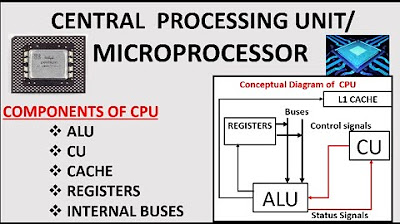What is a CPU?
Summary
TLDRThis video explains the essential functions of a central processing unit (CPU), highlighting its role in performing arithmetic, logic, and input/output operations. It outlines the basic fetch-decode-execute cycle, compares single-core and multi-core processors, and introduces multi-threading capabilities. Key CPU components such as the Arithmetic Logic Unit (ALU), Address Generation Unit (AGU), Memory Management Unit (MMU), and cache are described, emphasizing their importance in processing and memory management. Viewers are encouraged to learn more about CPUs and visit the provider's website for additional resources.
Takeaways
- 💻 A CPU (Central Processing Unit) is the electronic circuitry that executes the instructions of a computer program.
- 🔄 CPUs operate in a three-step process: fetch, decode, and execute instructions.
- 🤖 Microprocessor chips can have multiple CPUs, known as multi-core processors, which can handle several tasks simultaneously.
- 📈 Single-core processors can only handle one task at a time, unlike multi-core processors.
- 🧵 CPUs can be multi-threaded, allowing a single CPU to manage multiple threads of execution concurrently.
- 🔢 The Arithmetic Logic Unit (ALU) performs integer arithmetic and bitwise logic operations.
- 🏷️ The Address Generation Unit (AGU) calculates addresses for CPU to access main memory.
- 🛡️ The Memory Management Unit (MMU) translates logical addresses to physical RAM addresses and provides memory protection and paging.
- 🏎️ The cache in a CPU reduces the average time or energy required to access data from main memory.
- 👍 The video encourages viewers to like and subscribe for more information on CPUs and related topics.
Q & A
What is a CPU and what is its primary function?
-A CPU, or Central Processing Unit, is the electronic circuitry that performs basic arithmetic, logic, controlling, and input/output operations specified by a computer program. Its primary function is to execute instructions from the computer's memory.
What are the three steps a CPU follows to process instructions?
-The three steps a CPU follows to process instructions are fetch, decode, and execute. The CPU fetches instructions from memory, decodes the information into signals, and then sends these signals to the appropriate components.
What is the difference between a single-core and a multi-core processor?
-A single-core processor can handle one task at a time, while a multi-core processor can handle several tasks simultaneously, thanks to its multiple CPUs.
What does it mean for a CPU to be multi-threaded?
-A multi-threaded CPU can handle multiple threads of execution at the same time, allowing for increased efficiency and the ability to process more tasks concurrently.
What are the main components that make up a CPU?
-The main components of a CPU include the Arithmetic Logic Unit (ALU), the Address Generation Unit (AGU), the Memory Management Unit (MMU), and the cache.
What is the role of the ALU in a CPU?
-The Arithmetic Logic Unit (ALU) is a digital circuit that performs integer arithmetic and bitwise logic operations within the CPU.
What function does the AGU serve in a CPU?
-The Address Generation Unit (AGU) calculates addresses used by the CPU to access the main memory, facilitating data retrieval and storage.
How does the MMU contribute to the CPU's operation?
-The Memory Management Unit (MMU) translates logical addresses into physical RAM addresses, providing memory protection and paging abilities.
Why is a cache important in a CPU?
-The cache in a CPU is used to reduce the average time or energy required to access data from the main memory, thereby improving the overall performance of the system.
What is the purpose of memory protection and paging abilities provided by the MMU?
-Memory protection and paging abilities provided by the MMU ensure that different processes can run without interfering with each other's memory space, enhancing system stability and security.
How can one learn more about CPUs and related computer components?
-For more information about CPUs and related components, one can visit websites like radwell.com or connect with experts on social media platforms.
Outlines

このセクションは有料ユーザー限定です。 アクセスするには、アップグレードをお願いします。
今すぐアップグレードMindmap

このセクションは有料ユーザー限定です。 アクセスするには、アップグレードをお願いします。
今すぐアップグレードKeywords

このセクションは有料ユーザー限定です。 アクセスするには、アップグレードをお願いします。
今すぐアップグレードHighlights

このセクションは有料ユーザー限定です。 アクセスするには、アップグレードをお願いします。
今すぐアップグレードTranscripts

このセクションは有料ユーザー限定です。 アクセスするには、アップグレードをお願いします。
今すぐアップグレード関連動画をさらに表示

Media Pembelajaran : Struktur dan Fungsi CPU

PROCESSOR | Cara Kerja Processor Komputer - Di jamin 100% paham

CPU - Organisasi dan Arsitektur Komputer

CPU and Its Components|| Components of MIcroprocessor

IGCSE Computer Science 2023-25 - Topic 3: HARDWARE (1) - COMPUTER ARCHITECTURE - Von Neumann & CPU

The CPU and Von Neumann Architecture
5.0 / 5 (0 votes)
